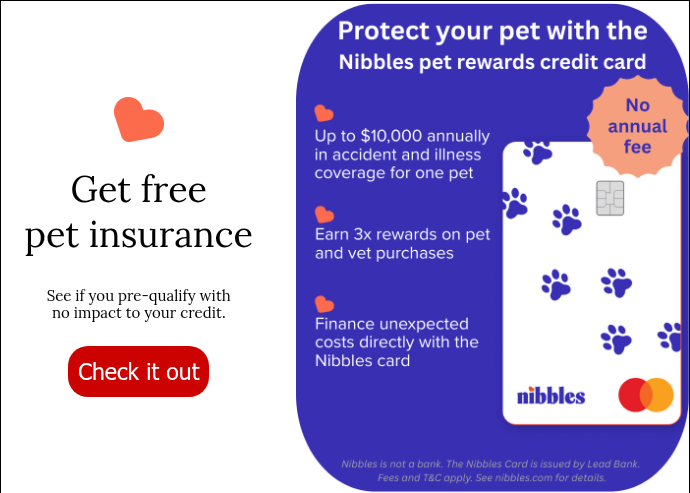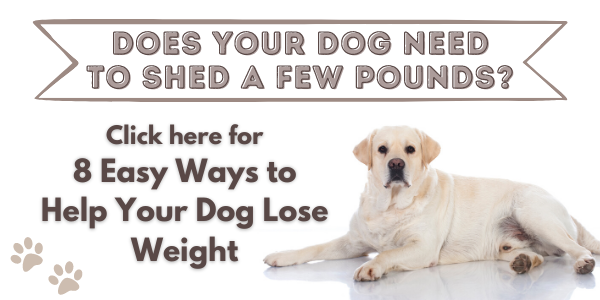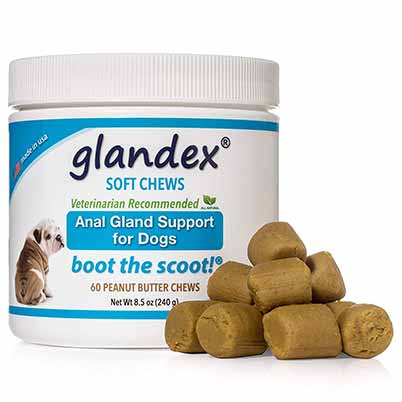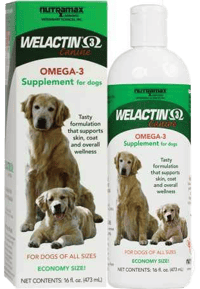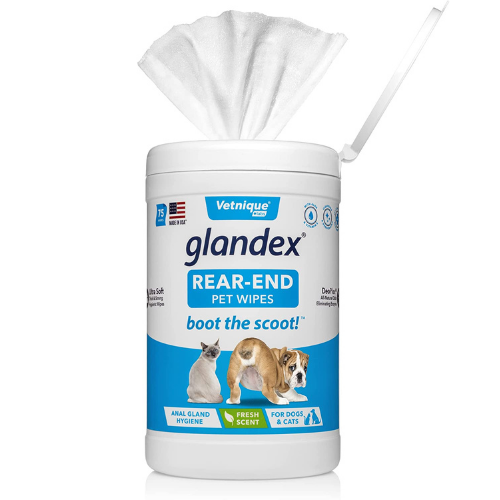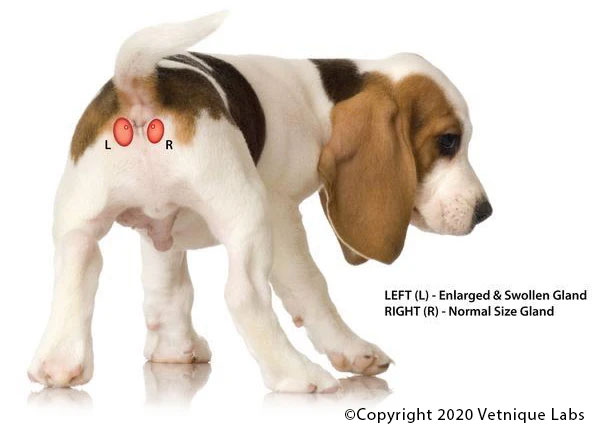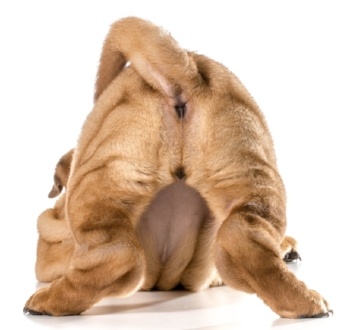
Oh, what a pain in the butt those anal glands can be!
It just seems to be a fact that most dogs have, at one time or another, problems with their anal glands.
There are times when the anal glands can become so impacted that they develop an infection, resulting in an abscess or cellulitis (inflammation in the surrounding tissue).
This situation is not only painful for the poor dog’s butt, but it also causes a nasty mess and can be distressing for you.
So, this leads one to ask, “Why in the world do dogs have these two little annoyances at their back end, and what can I do to help prevent my dog from suffering from regular anal gland problems?” Let's get to the bottom of it!
Skip to:
How Do Anal Glands Become Infected?
So how and why does this whole mess get started? The most common reason anal glands become a problem is when they get impacted (the foul-smelling liquid isn’t able to be expressed when the dog poops), causing the secretions to build up and become infected.
This impaction is uncomfortable, and the longer the secretions stay in the gland and start to thicken, the more painful it becomes, and a greater chance of rupture exists.
Once this process has started, the problems begin.
The following risk factors can alter the anatomy associated with the glands or affect your dog's poop (i.e., the consistency of the poop). And it's these factors that can predispose a dog to have more problems with their anal glands becoming infected.
Conditions that can increase the chances of anal gland problems include:
- Being overweight or obese
- Diarrhea (caused by illness, sudden food changes, inappropriate treats or food)
- Food hypersensitivities (food allergies)
- Atopic dermatitis (environmental allergies)
- Chronic (deep) skin infections with bacteria and/or yeast
- Abnormal anal tone – inability to contract the anal sphincter normally
- Obstruction of the anal gland duct – mass/tumor, inflammation of the muscles, etc.
- Skin mite infestations (e.g., Demodex, Sarcoptes)
The difference in anal glands between species
While both dogs and cats have anal glands and both species can develop infections, it is much more common for dogs than cats to get infections. This is likely a very good situation for us veterinarians because cats REALLY hate to have their anal glands expressed.
With that being said, even though it is my life’s goal for all pet owners to know how to express anal glands, I would advise that one does not try to express their cat’s anal glands at home but rather take them to a veterinarian.
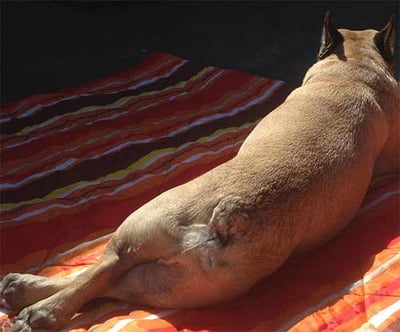
How is breed a factor?
As with species, there also seems to be a correlation to breed. In my experience, small-breed dogs, such as Poodles and Chihuahuas, seem to represent a higher proportion of dogs with anal gland problems versus larger-breed dogs. There are perhaps several reasons for this.
In my experience, smaller-breed dogs tend to be given more table food, which can cause their poop to be softer and therefore not cause adequate muscle contraction to express the glands.
Also, smaller breed dogs are generally more nervous and anxious than larger breeds – the well-known "Chihuahua shake and shiver." Typically, this alters the stool's firmness, and therefore, the glands are not expressed as they need to be.
Smaller breeds also tend to be less active, so the muscles in the rump are not as strong as in larger breeds. Weight distribution on smaller breeds is different from that of larger breeds. Even a little bit of extra weight can impact the expression of the glands (a Chihuahua that is one pound overweight is like a human gaining 33 pounds, whereas a beagle gaining 5 pounds only equates to a human gaining 20 pounds).
Another final possibility is that many small-breed dogs have hind-limb conformational issues. These can cause issues with their knees, such as luxating patellas (the kneecap moves in ways it shouldn’t!), that prevent them from squatting properly and holding a squat. This has an impact on the contraction of the muscle around the glands, causing poor expression of them.
How is age a factor?
Older pets seem to have issues more often than younger animals. The theory here is that they are unable to squat long enough and exert the same pressure pooping so that the fecal matter can push against the glands to express them naturally. The reason could also be a previous injury, arthritis, age-related health issues, etc.
Just to be clear, however, not all older pets have anal gland problems, but I recommend that if you have an older pet and they have some of the symptoms that are mentioned later in this article, you monitor them for anal gland issues.
How could grooming be a risk factor?
In my practice, I frequently saw more dogs with anal gland infections that were regularly groomed by a groomer, a groomer not associated with a veterinary practice.
Why, you may ask? The reason is that groomers can ONLY (usually by law) express anal glands externally – the difference between external and internal expression is explained later in the article. And the reason that this is an issue is that they cannot fully empty the gland completely, and therefore, they leave secretions behind; plus, they have also created inflammation, which narrows the already small duct that empties the gland.
The secretions are now deeper in the gland, and there is inflammation by squeezing the gland and surrounding muscles in an unnatural manner (causing swelling), so the secretions begin to thicken, and the infection starts to develop.
While no one wants their freshly groomed and pampered pet to smell like anal gland secretions, I highly suggest asking your groomer not to express your pet’s anal glands. I have found it best to bring your pet just before or just after grooming to a veterinary clinic to have the glands expressed internally by a trained veterinary staff member.
How to Tell When Your Dog Has a Problem With Their Anal Glands
The fortunate thing in most cases is that your pet will give you plenty of signs that there may be a problem. Some of these signs are more obvious than others, however. The good thing is that you know your dog better than anyone else, and you are likely to notice when things seem a little off.
If you see any of these signs repeatedly or know your dog has had a history of anal gland issues, it is likely a good idea to visit your veterinary clinic. The sooner the issue is evaluated by a veterinarian, the sooner your pet can become more comfortable and the happier you will be.
Is your dog scooting?
The most obvious sign that one sees is their pet dragging their butt on the ground (veterinarians refer to it as scooting, likely because it sounds cuter!). The reason dogs do this is to help express the glands, but also because the secretions make them itchy. Some other signs may be:
- Excessive licking at the rectum
- Reluctance to sit
- Chewing at the base of the tail or on the hip
- Foul odor may be noticed
- Blood on their poop
- Straining, vocalizing, or otherwise having difficulty or pain when pooping
- Swelling or bulging under the skin around the rectum
- Blood or pus on the carpet, their bed, or any other area where they have been resting
- In rare cases, I have seen difficulty walking
- NOTE: If you happen to be brave and express your dog’s glands (I recommend you use a white paper towel or large gauze pad), and if you notice the secretions are dark brown and there are any flecks/chunks or thickness, there is an infection. Bring your pet and the toweling with the secretions to the vet! Also, if your groomer expresses the glands, be sure to ask what the secretions looked like.
Questions? If you're concerned about your dog's anal glands and would like to speak with a veterinarian, Click here
How to Prevent or Lessen Anal Gland Issues
Have your dog seen by your veterinarian
The sooner you get your pet seen by a veterinarian, the sooner they can get relief, and, in all honesty, it'll likely be cheaper, in the long run, to have it treated sooner rather than later! Your veterinarian will do a full physical examination – this helps determine if there is another issue increasing the chances of anal gland problems. They'll conduct a visual and digital rectal exam (yup, poor pup gets a finger in their butt!).
I want to let you know that your dog may yelp or resist because, as mentioned earlier, the area is swollen and tender. But it's critical that your veterinarian does a complete exam, and the best way to check the anatomy as well as to express the glands is to gently “milk” them out from the inside (I often described it to my clients that it is like gently squeezing out a grape from its skin).
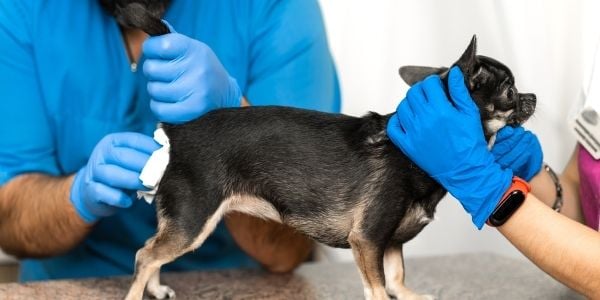
Your vet will explain the likely cause(s) of your dog’s anal gland issues. The cause may be as simple as your pet had a change in stool firmness or diarrhea from a change in treats or food. The loose stool prevented your dog from fully expressing their anal glands, and therefore, they developed an anal gland infection.
If your pet is overweight, your veterinarian will likely discuss your pet’s diet (the type of food and the quantity) and their exercise needs. In addition to food and exercise recommendations, your veterinarian may recommend blood work to determine other potential causes of excessive weight gain in your dog.
Such conditions include, but are not limited to, hypothyroidism or Cushing’s disease. If there are skin issues, your veterinarian may recommend your dog start on a special diet (commercially produced veterinary-prescribed limited ingredient diet or a true hypoallergenic diet). NOTE: Grain-free diets are not the same as true hypoallergenic diets. Pets are typically, though not always, allergic to a type of protein such as chicken, beef, soy, etc.
If your pet is given antibiotics for an anal gland infection – often a two-week course – be sure to have your pet rechecked by your veterinarian to be sure that the infection is cleared BEFORE the antibiotics are stopped. Another expression is usually done to determine if the infection is cleared or not.
Manage your dog's weight and consistency in diet
Maintaining your dog at an ideal body weight is not only helpful for anal gland issues, but it's also helpful for so many other conditions, like degenerative joint disease (arthritis). Your veterinarian can guide you to the best weight range for your dog.
Supplement your dog with joint supplements if they are overweight or older. It will help them walk and squat better. I have found Nutramax products to be the most consistent in their performance: Cosequin and Dasequin.
NOTE: If your pet is diabetic, check with your veterinarian before choosing a joint supplement.
Keep your pet’s main diet and treats consistent. Don’t switch things around weekly for variety. Their systems do not adapt like ours, and they can easily develop diarrhea.
If your dog is suffering from anal gland issues, do not give them rawhides, pig ears, bully sticks, or any other similar treats. I have found that they can be hard to digest (also, some can be very greasy), they overstimulate the pancreas, and then cause diarrhea. Then, the cycle of issues starts all over again.
Add fiber to your dog's diet
Something as simple as organic, no- to low-sodium canned green beans – cooked or uncooked without any additional seasoning. The added fiber helps bulk up the stool and, therefore, makes expressing the anal glands easier. Depending on the size of your dog, you can give ⅛ to ½ a cup per meal (more beans for a bigger butt!).
Another fiber source is canned pumpkin (not the pie mix, which has spices and sugar). BUT use caution on how much you use because it can cause diarrhea if you give too much. Start small and work your way up; stop before diarrhea starts.
Usually, again, depending on the size of your pet, start with ½ tsp twice to three times per day. Every few days, increase the amount (just go up by a ¼ to ½ tsp per day total) while monitoring your pet’s poop.
If you notice that the stool is getting less firm, cut back to the amount when it seemed firm.
There are also psyllium fiber supplements. You can sprinkle the psyllium fiber onto your dog's food. Since every dog and situation is different, talk to your veterinarian about the correct amount to add for your dog, and you can ask them to recommend a high-fiber diet if you want to try that instead.
NOTE: Please remember, with high-fiber diets or supplements, you must be sure that there is plenty of fresh water available for your pet.
Note: If you get a fiber product other than the ones recommended in this article, like Metamucil, make 100% certain that it doesn't contain the sweetener xylitol. Xylitol is extremely toxic to dogs, even at very low doses. And it is NOT an artificial sweetener, so don't assume it's safe just because the packaging says, "No Artificial Sweeteners."
Recommended Fiber Supplements for Dogs
There are veterinary products that are specifically formulated to help with this issue. Two such products are No Scoot and Glandex. Several of the Preventive Vet team's dogs have used the Glandex chews featured below with good results.
Pro Tip: If your dog has a suspected or known food hypersensitivity (food allergy) causing or worsening their anal gland problems, opt for the Glandex Peanut Butter chews rather than the beef flavored powder. Beef is a protein source that can be a common culprit for food allergies in food-sensitive dogs.
Add fish oil to your dog's diet
Adding fish oil to your dog's diet can help. And fish oil is also great for their skin as well as their joints. It acts as a natural anti-inflammatory. Honestly, even if your dog doesn’t have anal gland issues, I recommend fish oil.
Recommended Fish Oils for Dogs
Nutramax Welactin – The high concentration of EPA and DHA Omega-3 fatty acids, as well as the tasty liquid format, make this fish oil a great and easy-to-use supplement for dogs — just mix it in with either dry or canned food. And it's made by Nutramax, a reputable and trusted brand within the pet supplement industry.
Vetoquinol Omega – Made by another trusted veterinary supplement brand, these Omega fatty acid capsules are an excellent choice for people who want to give fish oil supplements to their dogs in capsule form.
Make sure to buy the size that's appropriate for the size of your dog. It comes in small, medium, large, and giant breed sizes, as well as for cats, so choose the size appropriate for your pet.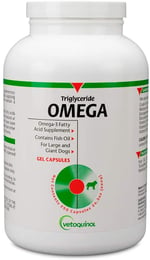
How to Express Anal Glands
This is a task most pet owners do not enjoy. It's a job often best left to trained veterinary team members. However, you can ask your veterinarian if they will teach you the proper way to express anal glands – the internal method.
I must warn you that this is not for the squeamish! It can be smelly and messy. Also, if you learn how to do it, do not express your pet’s glands before going out or having company over. It never fails that you will get the foul-smelling secretions on yourself or on something in the surrounding area. Be sure to get the recommended “cleaning” supplies listed below.
As a final note, if you decide to learn how to internally express your pet’s glands, BE CAREFUL not to repeatedly or aggressively express them (squeeze too hard) because there is a risk of some degree of inflammation and tissue damage.
Questions? If you're concerned about your dog's anal glands and would like to speak with a veterinarian, Click here
External Anal Gland Expression
I do not recommend you express your dog's anal glands using the external method for the reasons I mentioned above about groomers doing it and the problems that it causes. It pushes the secretions deeper into the gland, creating inflammation in the gland as well as the surrounding tissue.
This inflammation causes the small duct opening to be further blocked off. Therefore, making it hard, if not impossible, for your pet to express the glands themselves.
Internal Anal Gland Expression
Here's a good video where our friends at Glandex show you how to express your dog's anal glands at home. Two notes to add about the video, though: (1) I recommend using a bit of lube (Surgilube, Vaseline, or KY) on your finger when doing this method, and (2) I recommend having a wipe or paper towel in your hand, covering the rectum, whenever expressing the anal glands — regardless of whether you're doing the "external" or "internal" method, success can be VERY messy!!
How to express/squeeze dog anal glands
How Often Should Anal Glands Be Expressed?
Ideally, never having to express the anal glands manually would be the best for everyone! All kidding aside, the less often, the better. If your dog has only had an issue once and the infection is cleared, they may never have a problem again, especially if the cause can be identified and corrected.
I usually recommend having the glands checked once, about 4 weeks after being cleared of the infection. If your pet seems fine from that point on, with none of the indicator signs evident, leave them alone.
If, however, your pet has had a few episodes, I recommend that after the infection is cleared, recheck about every 4 weeks for a few months (also, during this time, try to implement some of the prevention methods recommended above).
If at each visit there appear to be no issues, begin to gradually extend the period of time between expressing the glands. For example, wait 6 weeks between if that seems to work, try extending to 8 weeks, etc.
But at the first sign of scooting or dragging their butt, be sure to have your pet checked. Sometimes, if you address it soon enough, they just need help expressing the glands without an infection developing.
Also, I recommend that if your pet has had loose stool or diarrhea (hint: monitor their stool regularly during the week), get the glands expressed once it has cleared, just as a precaution.
Gloves and Cleanup
If you find that you need to express your dog's anal glands manually, you can check the video above to learn how to do so at home. But first, make sure you're loaded up on the necessary supplies.
Grab a supply of latex-free, powder-free gloves as well as some things to clean up afterward and deal with the smell, such as waterless shampoo or "butt deodorizer" – you can spray it both on your pet's butt and in the air, and even on the carpets/floors/walls/drapes if anything from the anal glands squirts past your paper towel.
These Glandex wipes have vitamin E and conditioners, as well as a deodorizer. These wipes are used a lot in veterinary practices.
What Are Anal Glands and Why Do Dogs Have Them?
Anal glands are scent glands – some people refer to them as “anal sacs.” They range in size from a pea to a kidney bean, based on the size of your dog. They're located on either side of the anus and lie between the external anal sphincter and the smooth muscle of the rectum.
These glands are lined with secretory-type cells, which have numerous modified sweat and sebaceous (oil) glands. These two features within the lining of the gland produce the lovely foul-smelling liquid that contributes to the issues.
When all is right with the world, these glands are emptied when your dog (or cat) poops because the external anal sphincter compresses the glands against the feces (good old poop) within the rectum (this point will become important to remember later!). And the sacs empty as a result.
The purpose of all this is so that dogs can mark their territory. The smell left behind on their poop acts as a "smell signal” for other dogs passing by. It is also involved with social interaction – the reason dogs sniff each other’s butts!
Since each dog's smell is unique to them, by sniffing each other, they learn things like: have they met before, is this dog a friend or foe, or do I like them. Oh, nature and its wonderful way of communication! So, as you can see, they DO serve a purpose, even if it isn’t a pleasant-smelling one.
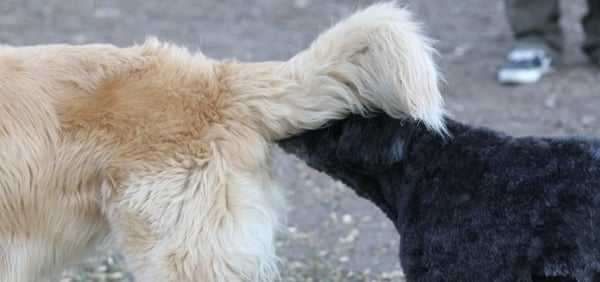
Ruptured anal glands
If your pet’s anal glands should rupture, there will be some blood and possibly pus, plus you will notice a small hole near their rectum. Either one or both glands can rupture. The opening usually sits, in relation to the rectum, at 4 and 8 o’clock or 5 and 7 o'clock. And one gland is always higher than the other.
While you may understandably panic when you first notice it, and your dog may be whimpering, it is typically not an emergency situation. However, I recommend calling your veterinarian and seeking medical advice.
Try not to let your dog lick, chew, or rub the area before visiting your veterinarian. Putting an e-collar (cone) on them will help. When talking to the veterinarian, be sure to be detailed in your description of the site and your dog’s health history. This will help them know best how to advise you on the next course of action.
Typically, when the anal gland ruptures, antibiotics and pain medication are needed. Also, depending on the size of the hole, surgery may be needed to close the opening.
Removing anal glands
There are some cases when a pet has chronically (continual and long-term) infected or impacted anal glands. When this happens, your veterinarian may recommend removing the glands – this is called an Anal Sacculectomy.
I recommend having your veterinarian explain to you all potential side effects of the procedure before having it done, so that you are completely aware and fully informed of all the risks and side effects.
One possible side effect is fecal incontinence – meaning your pet will have potentially little to no control over their ability to poop. It could just happen “out of the blue,” without warning.
There is also the risk of infection, dehiscence (opening of the surgical site due to location), anal stricture (narrowing or closure), rectal prolapse (protrusion or falling out of rectal tissue/membranes), as well as some others.
Also, be sure you are fully aware of all the costs, including those pre-operatively and post-operatively (especially if complications arise). While these side effects and costs can seem concerning, your veterinarian’s recommendation is based on what they feel is the best medical care for your dog to live a long, happy, and healthy life.
Some general practice veterinarians are comfortable with and can do the anal sacculectomy procedure, but some may suggest referral to a board-certified veterinary surgeon to minimize risks of complications arising.


